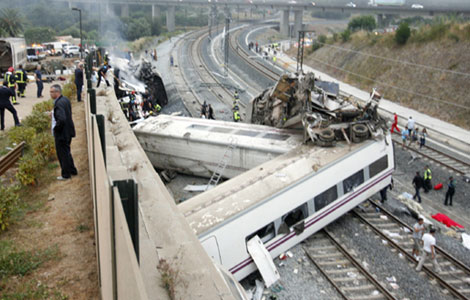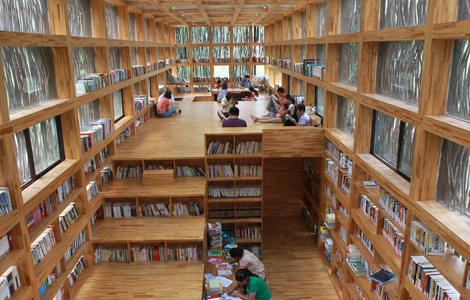
|
Although the landscape in Shenzhen has altered dramatically in recent decades, West Gangxia Village has seen little change. Yao Jing / China Daily |
|
Earmarked for development, East Gangxia Village has been razed to the ground. Yao Jing / China Daily |
Huge floating population poses tough transformation challenges for policymakers in Shenzhen
Urbanization, with all its advantages, has also created challenges for policymakers, and prominent among them is the resettlement of people from areas that are earmarked for redevelopment.
Looking at He Ling and two other villagers from Sichuan province playing cards in the shade of several multi-story buildings in West Gangxia village in the central business district of Shenzhen, one of the largest urban resettlements in China, it is easy to assume that hardly any such problems exist.
Looking up from his card game, with his hands on the makeshift table, the 36-year-old says that he and his companions have been living in the village ever since they came to Shenzhen a decade ago.
Though the landscape of Shenzhen has altered considerably since then, He says that he is luckier than many others as his village has not seen much change. "I can keep living and making money from the same place by doing the same small business of buying secondhand refrigerators, air-conditioners and other household appliances, and then selling them to factories and companies," he says.
Not all are so lucky. Just 1,000 meters away, East Gangxia Village has been razed to the ground. By 2017, a new urban complex with several skyscrapers will replace the seven and eight-story dwellings that made up the village.
He is just one of the 13 million people who have moved from the countryside or other cities in China to Shenzhen, a city adjacent to Hong Kong. Today, several urban villages, which have been home to the floating population, are facing renovation or reconstruction challenges due to an acute scarcity of land.
Apart from the two Gangxia Villages, there are about 240 urban villages across Shenzhen. Most of them have are being redeveloped, or retrofitted.
Urban complexes, which use the city space efficiently, are blossoming on many of these village sites that were originally home to farmers and other migrants.
Though the new urban complexes still sport the look and feel of a community, they are much more commercial, comprehensive and consistent with a modern city. Needless to say, the cost of such a face-change is also enormous.
Shenzhen has long been regarded as a pioneer of China's urbanization. In 1979 it had roughly 30,000 people when the late leader Deng Xiaoping made it a Special Economic Zone. Today it is a thriving metropolis of over 12 million whose population has risen by 56 percent in the last decade.
The population density in Shenzhen has risen to 17,150 people per square kilometer, making it fifth in the list of global megacities ahead of even Shanghai and Beijing. From a small fishing village, Shenzhen has become a city with 22 urban complexes, and a further seven are likely to be added before 2015, says information provided by WorldUnion, a Shenzhen-based real estate consultant.
Among the city's eight districts, Futian, the hub of living in Shenzhen, and Nanshan, which encompasses the southwest area of Shenzhen, are the two development hot spots with mushrooming urban areas where office buildings, shopping malls, residences and related public facilities are coming up.
"In Futian district, more than 70 buildings are generating more than 1 billion yuan in tax revenue every year. Most of them are multi-functional buildings where high-rise floors are used for offices and apartments, while lower-level areas are for commercial purposes," says Xie Huihui, director of Futian District Urban Redevelopment Authority.
That in itself is a major transformation from the old village economic model of landlords, mostly local people, charging rent. Without unified planning, most of the earlier buildings were built according to the whims and fancies of the landlords, and in many cases gave an impression of being dirty and unsafe.
"Some of these buildings are in the core of Shenzhen, and look extremely old and shabby. Due to economic development, more space is in need for industrial upgrades. Therefore, we have no choice but to create more space through modification and reconstruction," Xie says.
According to Xie, policymakers in Shenzhen have decided to develop eight areas in Futian district, each one with a featured industry. "Municipal supporting systems like transportation, medical facilities, education and community services, are also being planned in the new city complexes," he says.
Gemdale Dabaihui Corporation, a Chinese real estate development company, is currently undertaking the process of demolition and reconstruction of East Gangxia Village.
"We signed the contract with the local government in 2006. However, it took us seven years to resettle 100,000 people from the village, which occupies 220,000 square meters of flat area," says Hu Weiming, general manager of Gemdale Dabaihui Corporation (Shenzhen).
From Hu's office, a high-rise building near the village, can be seen the yellow earth and the demolition work that has already been done.
"On the land, we will build two office buildings, six high-end apartments, an art center, one exhibition hall, and a business area of over 300,000 square meters," Hu says.
The project, which is estimated to be finished in 2017 with an investment of 16 billion yuan, will be the final piece of the Shenzhen central business district.
"Prior to the renovation, land banks in the city were often scattered. But with the new urban complexes, there is a rational, ordered and optimal use of the land," Hu says.
The original village will continue to be an integral part of the new city, he says. "What we are trying to do is to ensure that the villagers earn more money through the newly developed properties.
"We compensate villagers in the proportion of one to one in accordance with the size. With more than 600,000 square meters area earmarked for residents, we are confident that nearly two thirds will be returned to villagers," Hu says.
Meanwhile the floating population that used to live in the village has moved on to other nearby village-in-cities. Once the complex is finished, some of them will come back.
Unlike the massive reconstruction in East Gangxia, real estate developer Costal Group had little problems in setting up a huge facility at its property in Nanshan district, originally a fishing village in the southwest of Shenzhen.
"When we came here in 1999, it was a pool farming oysters, fishes and shrimps. We decided to join the land filling project of the government," says Zhu Liwei, director of Costal Group.
Zhu says he bid for four pieces of land from the government, two for office buildings and two for commercial complexes.
"We have sold the office buildings and are currently playing the role of a property manager. The property adjacent to the total 120,000-square meter commercial center belongs to us," Zhu says.
According to Zhu, there was hardly any commercial area, except for some small shops along old streets, in the district. After the establishment of the Shenzhen Bay Cross-Sea Bridge (Hong Kong-Shenzhen Western Corridor) in 2007, which shortened the driving distance between Shenzhen and Hong Kong, Zhu says the potential for commercial business started gaining ground in Nanshan district.
However, his business was not so smooth in the beginning, he admits.
"We never had enough workers. Most of our customers were local people and they preferred only low-end products." In 2007, there were just 1 million people living in Nanshan district, Zhu adds.
With the district being developed now and new companies moving in, there has been an increase in the number of white-collar workers are using the shopping mall, especially during daytime.
"We are planning to upgrade the level of brands. A Hong Kong restaurant, which sold a set meal priced at 40 yuan, has now become a high-end restaurant providing a dedicated menu," Zhu says.
"Although business at the shopping mall is somewhat affected by the easy access to Hong Kong, it still fills a commercial gap in the district."
Zhu says that his company is now considering similar projects in Wuxi and Jiangyin in Jiangsu province.
As a relatively cheap place to live, urban villages attract many city newcomers.
Xiong Chuanxin, who came to Shenzhen in 1999, started his metropolitan dream in the new Hubei Village in Luohu district.
"Until 2002, I had lived in three different villages, including Huanggang and Xiasha Village," says the 39-year-old middle manager at a real estate company.
"First, I lived with two friends and did not pay any rent. In 2001, I moved to Xiasha Village, and the 30 square-meter house cost 600 yuan while nearby commercial areas asked for more than 2,000 yuan."
Today, Xiong, whose first job in the city was selling coconut milk, lives in a new 120-square meter house. Still, he says each newcomer to the city has the experience of living in a village. "It is cheap, and very close to the work place. We just feel that everyone's fate in the village is similar, and the relationship among people was equal and warm," he says.
Others like He Ling say they do not want to move out of their urban villages, to return to their hometowns. "I am now accustomed to the life in Gangxia Village. It makes me feel like a city dweller, although it is still a village," he says.
"Average rents have increased to 1,500 yuan from less than 300 yuan 10 years ago for a 30-square meter house. But it is much lower when compared with nearby areas." He adds that he seldom goes out of the village, as most of the basic necessities are available there.
Contact the writers through yaojing@chinadailly.com.cn
(China Daily Africa Weekly 07/26/2013 page14)








